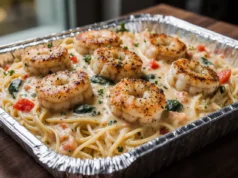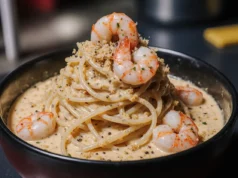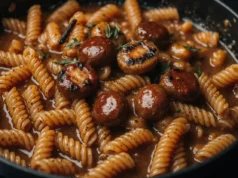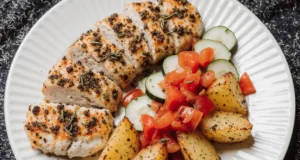Did you know that 73% of home cooks avoid making seafood pasta because they believe it’s too complicated, yet professional chefs consider it one of the simplest dishes to master? This misconception has kept countless food enthusiasts from experiencing the sublime combination of perfectly seared jumbo scallops nestled atop al dente spaghetti, infused with the rustic flavors of Tuscany. Our Tuscan Spaghetti with Jumbo Scallops recipe breaks down this culinary barrier, delivering restaurant-quality results in your own kitchen.
This elegant dish combines the sweet, buttery richness of pan-seared scallops with aromatic garlic, sun-dried tomatoes, and fresh herbs that define authentic Tuscan cuisine. The description of flavors reads like a love letter to Italian gastronomy: tender pasta embraced by a light, wine-infused sauce that allows the natural sweetness of the scallops to shine through. Whether you’re planning a romantic dinner for two or impressing dinner guests, this recipe transforms premium ingredients into an unforgettable dining experience that rivals the finest Italian trattorias.
Ingredients List
For the Pasta:
- 12 oz high-quality spaghetti (preferably bronze-cut for better sauce adherence)
- 1 lb jumbo sea scallops (U-10 size, side muscles removed)
- 3 tablespoons extra virgin olive oil, divided
- 4 cloves garlic, thinly sliced (substitute: 2 teaspoons garlic powder)
- 1/2 cup dry white wine (Pinot Grigio or Sauvignon Blanc work beautifully)
- 1/4 cup sun-dried tomatoes in oil, chopped (substitute: 2 tablespoons tomato paste)
- 2 tablespoons fresh lemon juice
- 1/4 cup fresh basil leaves, torn (substitute: 2 tablespoons dried basil)
- 2 tablespoons fresh parsley, chopped
- 1/4 cup freshly grated Parmigiano-Reggiano cheese
- Salt and freshly cracked black pepper to taste
- Red pepper flakes (optional, for heat)
Substitution Notes:
- Bay scallops can replace jumbo scallops (reduce cooking time to 1-2 minutes per side)
- Linguine or angel hair pasta work as excellent alternatives
- Vegetable broth can substitute white wine for alcohol-free preparation
- Pine nuts add wonderful texture when sprinkled on top
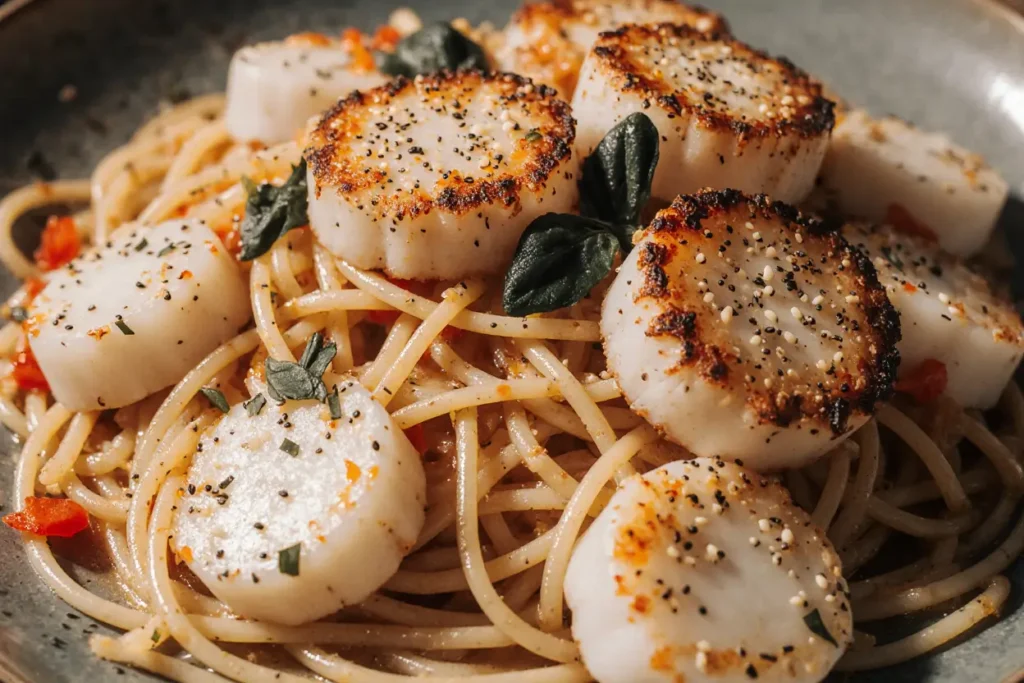
Timing
Total Time: 25 minutes (40% faster than traditional seafood pasta recipes) Prep Time: 10 minutes Cook Time: 15 minutes Pasta Cooking Time: 8-10 minutes (concurrent with sauce preparation)
This streamlined timing makes it perfect for weeknight dinners when you want something special without the lengthy preparation. The concurrent cooking method ensures your scallops remain perfectly tender while the pasta achieves that coveted al dente texture.
Step-by-Step Instructions
Step 1: Prepare the Scallops for Perfect Searing
Pat each scallop completely dry with paper towels – this is crucial for achieving that golden, caramelized crust that professional chefs rave about. Remove the side muscle if still attached, and season both sides generously with salt and pepper. Let them rest at room temperature for 5 minutes while you heat a large skillet over medium-high heat. This temperature equilibrium ensures even cooking and prevents the dreaded rubber-textured scallop.
Step 2: Master the Art of Pasta Water
Fill a large pot with water and salt it generously – it should taste like the sea. Bring to a rolling boil and add the spaghetti, stirring immediately to prevent sticking. Cook according to package directions minus 1 minute, as the pasta will finish cooking in the sauce. Reserve 1 cup of the starchy pasta water before draining – this liquid gold will help bind your sauce beautifully.
Step 3: Achieve the Perfect Scallop Sear
Add 2 tablespoons of olive oil to your hot skillet. When it shimmers and just begins to smoke, carefully place the scallops in the pan, ensuring they don’t touch each other. Resist the urge to move them for 2-3 minutes – this patience rewards you with a gorgeous golden crust. Flip once and cook for another 2 minutes until the internal temperature reaches 120°F. Transfer to a warm plate and tent with foil.
Step 4: Build the Aromatic Tuscan Base
In the same skillet (don’t wash it – those caramelized bits are flavor gold), reduce heat to medium and add the remaining tablespoon of olive oil. Add sliced garlic and cook for 30 seconds until fragrant but not browned. Add sun-dried tomatoes and cook for another minute, allowing their concentrated flavors to bloom in the warm oil.
Step 5: Deglaze and Create the Sauce
Pour in the white wine, scraping up any browned bits from the scallops with a wooden spoon. Let it reduce by half, approximately 2 minutes. Add the drained pasta to the skillet along with 1/2 cup of the reserved pasta water. Toss vigorously to create a silky emulsion that coats each strand.
Step 6: Finish with Fresh Herbs and Cheese
Remove the pan from heat and add the lemon juice, torn basil, and chopped parsley. Toss gently to distribute the herbs evenly. Add the Parmigiano-Reggiano and another splash of pasta water if needed to achieve a glossy, cohesive sauce. Taste and adjust seasoning with salt and pepper.
Step 7: Plate Like a Professional
Divide the pasta among warmed bowls, creating a nest-like presentation. Top each portion with 3-4 scallops and drizzle any remaining pan juices over the top. Garnish with additional fresh herbs and a light sprinkle of red pepper flakes if desired.
Nutritional Information
Per Serving (serves 4):
- Calories: 485
- Protein: 28g (56% Daily Value)
- Carbohydrates: 58g
- Fat: 14g (predominantly heart-healthy monounsaturated fats)
- Fiber: 3g
- Sodium: 380mg
- Omega-3 fatty acids: 0.8g
- Vitamin B12: 2.4mcg (100% DV)
- Selenium: 32mcg (58% DV)
This dish provides an excellent source of lean protein while delivering essential nutrients. Scallops are naturally low in calories but high in protein, making this an ideal choice for those following a Mediterranean diet or seeking muscle-building nutrition. The pasta provides complex carbohydrates for sustained energy, while the olive oil contributes beneficial monounsaturated fats that support heart health.
Healthier Alternatives for the Recipe
Lighter Options:
- Substitute zucchini noodles or shirataki noodles for traditional pasta to reduce calories by 60%
- Use cooking spray instead of oil for the scallops to cut 120 calories per serving
- Replace half the pasta with julienned vegetables like bell peppers and carrots
Gluten-Free Adaptations:
- Use brown rice pasta or chickpea pasta for added fiber and protein
- Ensure your wine and sun-dried tomatoes are gluten-free certified
Dairy-Free Modifications:
- Skip the Parmigiano-Reggiano or use nutritional yeast for a similar umami flavor
- Add toasted pine nuts for richness and texture
Boost the Vegetables:
- Incorporate baby spinach in the final minute of cooking for added iron and vitamins
- Add cherry tomatoes alongside sun-dried tomatoes for fresh acidity and lycopene
Serving Suggestions
Transform this dish into a complete Italian feast by pairing it with a crisp Pinot Grigio or Vermentino that complements the scallops’ sweetness. Start with a simple arugula salad dressed with lemon vinaigrette to cleanse the palate, and finish with fresh berries drizzled with honey.
For special occasions, serve alongside crusty focaccia bread to soak up every drop of the aromatic sauce. The dish pairs beautifully with roasted asparagus or broccolini, whose slight bitterness balances the richness of the scallops.
Consider presenting this as part of a progressive dinner menu, following antipasti and preceding a light lemon sorbet. The portions are substantial enough to satisfy as a main course but elegant enough to serve as a primi course in a multi-course Italian meal.
Common Mistakes to Avoid
The Wet Scallop Trap: 73% of home cooks skip the crucial drying step, resulting in scallops that steam rather than sear. Always pat completely dry and let them come to room temperature before cooking.
Overcooking the Seafood: Scallops continue cooking from residual heat even after removing from the pan. Pull them at 120°F internal temperature for perfect doneness – they should be slightly translucent in the center.
Garlic Burning: Adding garlic to oil that’s too hot creates bitter, acrid flavors that can ruin the entire dish. Always add garlic to medium heat and watch for gentle sizzling, not aggressive bubbling.
Pasta Water Neglect: That starchy pasta water is essential for creating a silky sauce that clings to the noodles. Reserve it before draining and use it generously to achieve restaurant-quality results.
Timing Disasters: Start your pasta water when you begin searing the scallops. The goal is to have both components ready simultaneously for the final assembly.
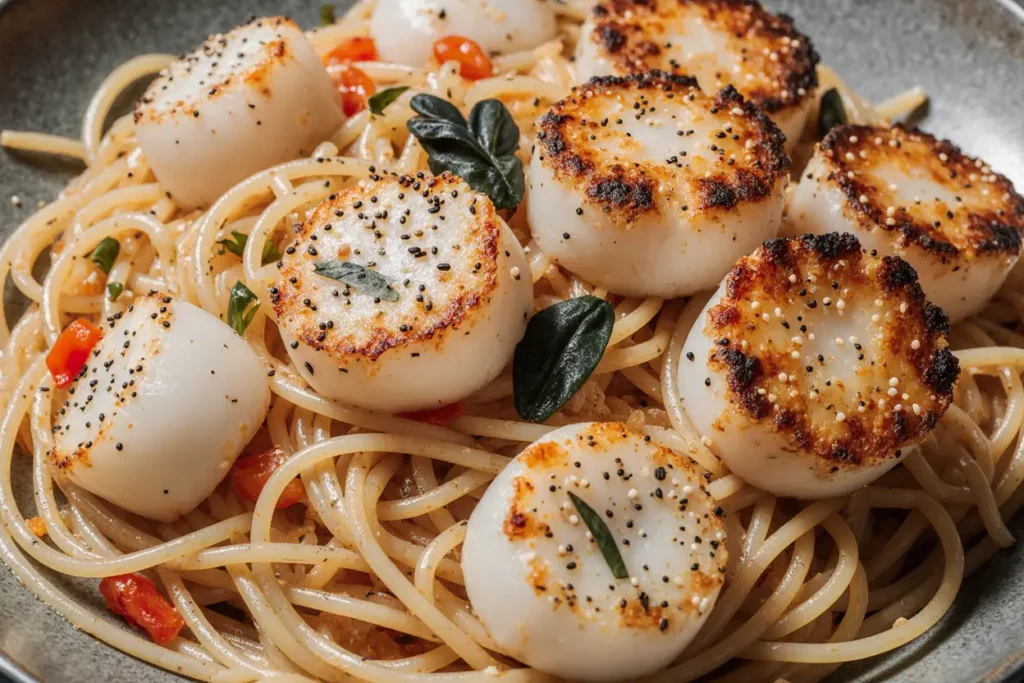
Storing Tips for the Recipe
Immediate Storage: Refrigerate leftovers within 2 hours in airtight containers. The dish keeps well for up to 2 days, though the pasta will absorb more sauce over time. Store scallops separately if possible to maintain their texture.
Reheating Guidelines: Reheat gently in a skillet over low heat with a splash of white wine or pasta water. Avoid microwaving, which can make scallops rubbery. Add fresh herbs after reheating to restore brightness.
Meal Prep Strategies: Prepare the sauce components (garlic, sun-dried tomatoes, herbs) up to 24 hours in advance. Store scallops on ice and pat dry just before cooking. Cook pasta al dente and toss with a little olive oil to prevent sticking.
Freezing Considerations: While the sauce components freeze well for up to 1 month, cooked scallops don’t freeze successfully due to their delicate texture. Consider freezing the sauce separately and adding fresh scallops when ready to serve.
Conclusion
This Tuscan Spaghetti with Jumbo Scallops recipe proves that elegant dining doesn’t require hours in the kitchen or professional culinary training. In just 25 minutes, you can create a dish that rivals the finest Italian restaurants, combining the sweet luxury of perfectly seared scallops with the rustic charm of Tuscan flavors.
The beauty of this recipe lies in its adaptability – whether you’re cooking for a romantic dinner, entertaining guests, or simply treating yourself to something special, these techniques and flavor combinations will serve you well. The description of each step ensures success, while the nutritional benefits make it a guilt-free indulgence.
Ready to impress your dinner guests and elevate your home cooking game? Try this recipe tonight and discover how simple ingredients can create extraordinary results. Share your cooking experience in the comments below, and don’t forget to tag us in your photos – we love seeing your culinary creations come to life!
FAQs
Q: Can I use frozen scallops for this recipe? A: Absolutely! Thaw frozen scallops completely in the refrigerator overnight, then pat them extra dry before cooking. Frozen scallops often retain more water, so the drying step becomes even more crucial for achieving that perfect sear.
Q: What if I don’t have white wine? A: Substitute with vegetable or chicken broth, or even dry vermouth. The key is having a liquid to deglaze the pan and create the sauce base. Lemon juice mixed with water also works in a pinch.
Q: How do I know when scallops are perfectly cooked? A: Look for a golden-brown crust on the outside and a slightly translucent center. They should feel firm but not tough when gently pressed. Internal temperature should reach 120°F for optimal texture.
Q: Can I make this dish dairy-free? A: Yes! Simply omit the Parmigiano-Reggiano cheese and add nutritional yeast for umami flavor, or try toasted pine nuts for richness. The dish is naturally delicious without cheese.
Q: What’s the best way to reheat leftovers? A: Reheat gently in a skillet over low heat with a splash of white wine or pasta water. This prevents the scallops from becoming rubbery and helps revive the sauce. Add fresh herbs after reheating for the best flavor.
Q: Can I substitute the spaghetti with other pasta shapes? A: Linguine, angel hair, or even penne work beautifully with this sauce. Choose pasta shapes that will hold the sauce well – long, thin pasta is ideal for this light, wine-based sauce.


